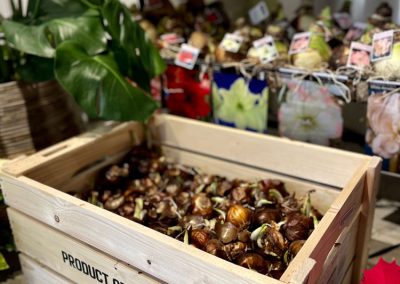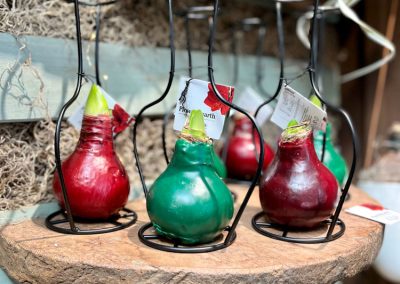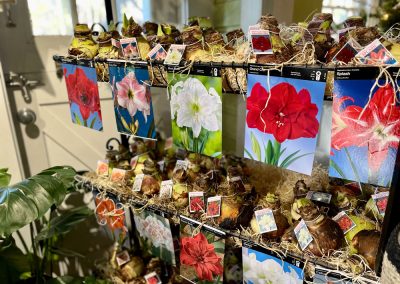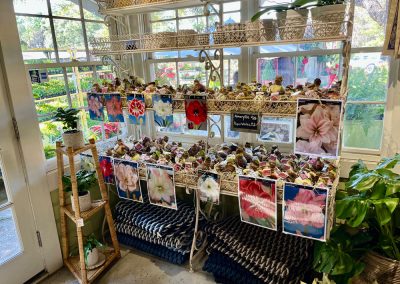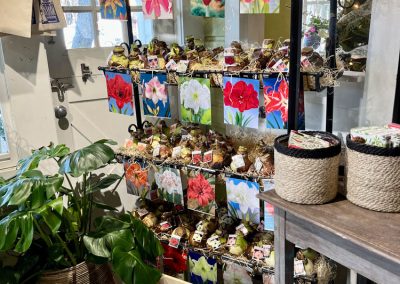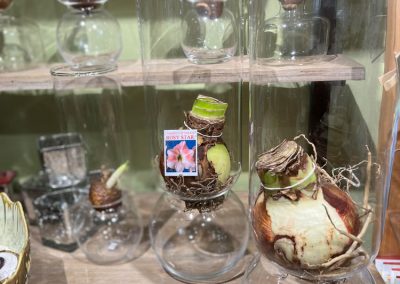Amaryllis

Fun Facts
- The genus Amaryllis is a native to Africa and the root word in Greek “Amarysso” means “To sparkle.”
- Based on Greek mythology: Amaryllis, a young maiden desperate to win the love of Alteo, a handsome shepherd. She pierced her heart with a golden arrow and visited his cottage each day shedding blood droplets along the way. On the 13th day, beautiful scarlet flowers bloomed along the path. He was smitten and she was healed!
- The bulbs were brought to Europe in the 1700s and with loving care, are known to live and bloom for nearly 75 years.
- In the 1800s, this flower was reclassified under the genus Hippeastrum. The Greek words for “Horse” and “Star.”
- Amaryllis can re-bloom every year, by cutting back the expired flower stalks to about 1” above the bulb.
- Plant breeders have developed over 600 named varieties.
- In Nature, Amaryllis blooms in spring or summer but is commonly forced into early bloom for the holidays.
Location
- Place the pot in a location that receives bright and indirect light.
- Blooming will begin in six to eight weeks after planting while other varieties may take ten weeks.
- As the plant grows, turn the pot periodically to encourage the flower stalks to grow straight.
- These plants will reach 2 feet in height and may produce 6 flowers per stalk
- Before planting, inspect the Amaryllis bulbs carefully to ensure they are firm and disease free.
- If planting outdoors, assess those conditions and water carefully.
Water
- Water regularly, but sparingly until a 2” new growth is visible.
- Thereafter, water regularly with care.
- Be sure to maintain measured watering so as not to dry out causing the soil to pull away from the sides of the pot.
- Water with room temperature water and thoroughly wet the potting medium.
- Leave the soil alone, almost entirely, and in most conditions, will create the environment for growth.
Temperature
- Amaryllis are tender perennials, most are hardy outdoors in zones 9-11.
- As the plant matures, flower buds will appear on the top of each stalk with a dramatic floral display.
- To prolong the blooms, keep the pot out of direct sunlight.
Soil/Fertilizer
- The Amaryllis is a flowering bulb that grows in gardens, flower beds, or pots.
- Pack the soil gently around the bulb (Pointed-end up), approximately one-third of the bulb remains above the soil line.
- Do not use soil from the garden because it will not drain properly for this flowering bulb if placed indoors.
- The bulb within itself contains all the necessary nutrients for the Amaryllis to sprout and bloom.
- However, if you desire to keep to re-bloom the following year, fertilize as you would a house plant.
- Plant the bulb in good potting soil and insert a support stake to keep the blooms upright.
Pests
- Carefully inspect the Amaryllis bulb for soft rotten areas before planting.
- Use a Soil drench containing the biological insecticide Bacillus thuringiensis var.
- Preventative bug management: Use Yellow or LED bulbs or citronella candles.
- Best natural deterrents: Spray solutions mixed with water and either: Epsom salt, baking soda, or 50% alcohol.
- Kill aphids by spraying a solution of 2 tsp. dish soap and 1 qt. of medium warm water on your plant. The soap removes the protective coating on the aphids and causes them to die of dehydration.
Contact Us
address
4808 East Scenic Hwy 30A
Seagrove Beach, FL. 32459 (google map)
phone: 850.231.2150
hours: 9-5 Monday thru Saturday | Sun. 12-5
